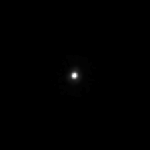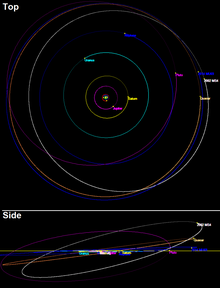(307261) 2002 MS 4
|
Asteroid (307261) 2002 MS 4 |
|
|---|---|

|
|
| 2002 MS 4 through the Hubble Space Telescope | |
| Properties of the orbit ( animation ) | |
| Orbit type | DO or CKBO («Hot»), «Distant Object» |
| Major semi-axis | 42,012 AU |
| eccentricity | 0.139 |
| Perihelion - aphelion | 36,174 AU - 47,849 AU |
| Inclination of the orbit plane | 17.7 ° |
| Length of the ascending node | 215.9 ° |
| Argument of the periapsis | 213.3 ° |
| Time of passage of the perihelion | December 10, 2122 |
| Sidereal period | 272 a 3.7 M |
| Mean orbital velocity | 4.558 km / s |
| Physical Properties | |
| Medium diameter | |
| Albedo | |
| Absolute brightness | 4.0 ± 0.6 mag |
| Spectral class | BV = 0.69 ± 0.03 V-R = 0.38 ± 0.02 B-R = 1.07 ± 0.04 |
| history | |
| Explorer |
Chadwick A. Trujillo Michael E. Brown Eleanor F. Helin Steven H. Pravdo Kenneth J. Lawrence Michael Hicks |
| Date of discovery | June 18, 2002 |
| Source: Unless otherwise stated, the data comes from JPL Small-Body Database Browser . The affiliation to an asteroid family is automatically determined from the AstDyS-2 database . Please also note the note on asteroid items. | |
(307261) 2002 MS 4 is a large trans-Neptunian object in the Kuiper belt , which is classified as a Cubewano or extended scattered disk object (DO) in terms of its orbit dynamics . Due to its size, the asteroid is a dwarf planet candidate and the largest known unnamed planetoid in the solar system .
discovery
2002 MS 4 was discovered on June 18, 2002 by an astronomical team from the California Institute of Technology , consisting of Chad Trujillo and Mike Brown (officially) as well as Eleanor "Glo" Helin , Steven H. Pravdo, Kenneth Lawrence and Michael Hicks as part of the Near Earth Asteroid Tracking Project (NEAT) discovered at the 1.2 m Oschin Schmidt telescope of the Palomar Observatory ( California ). The discovery was made on 21 November 2002 along with 2002 VR 128 and 2002 QX 47 announced the asteroid was on 16 December 2011 by the IAU , the Minor Planet -number 307261 .
2002 MS 4 was the second discovery of a large TNO and likely dwarf planet by Mike Brown's team of astronomers after Quaoar (2002). Brown's team then discovered Sedna (2003) and Haumea (2003, controversial), Orcus and Salacia (2004), the dwarf planets Eris and Makemake (2005) and Gonggong (2007).
After its discovery, MS 4 could also be found on older recordings from June 1992, July and June 1983, August 1982, April 1955 and up to April 8, 1954, which were also recorded at the Palomar as part of the Digitized Sky Survey program (DSS). Observatory were made to identify going backwards and thus extend its observation period by 48 years in order to calculate its orbit more precisely. Since then, the planetoid has been observed through various telescopes such as the Herschel and Spitzer space telescopes as well as earth-based telescopes. In April 2017, there were a total of 62 observations over a period of 57 years. The last observation so far was carried out in June 2018 at the Vegaquattro Observatory ( Piedmont ). (As of March 13, 2019)
properties
Orbit
2002 MS 4 orbits the sun on a slightly elliptical orbit inclined by 17.67 ° to the ecliptic with a perihelion of 35.98 AU and an aphelion of 47.77 AU. The orbital eccentricity is accordingly 0.141, its period around 272 years. The planetoid is currently 46.63 AU from the Sun. The next time it passes through perihelion in 2122, the last perihelion should have been in 1850.
Marc Buie ( DES ) classifies the asteroid as an extended SDO (ESDO or DO ), while the Minor Planet Center classifies it as a Cubewano , whereby it belongs to the classical KBO in terms of orbital dynamics ; the latter also lists it as a non-SDO and generally as a “distant object”.
size
Research with the Spitzer Space Telescope gave an estimate of the asteroid's albedo of 0.08, which would result in a diameter of approximately 700 km. Combined with the data from the Herschel space telescope, an albedo of 0.05 and a diameter of 934 kilometers could be determined. Based on the latter diameter, the total surface area is around 2,740,000 km². Other TNOs of this size are Sedna , Salacia and Orcus . The apparent magnitude of 2002 MS 4 is 20.67 m ; the mean surface temperature is estimated at 43 K (−230 ° C) based on the distance from the sun .
Since it can be assumed that 2002 MS 4 is in hydrostatic equilibrium due to its size and must therefore be largely spherical in shape, it would have to meet the criteria for classification as a dwarf planet . Mike Brown assumes that 2002 MS 4 is almost certainly a dwarf planet. Gonzalo Tancredi did not make a recommendation in 2010.
| year | Dimensions km | source |
|---|---|---|
| 2007 | 726.2 +123.2−122.9 | Stansberry et al. a. |
| 2008 | 730.0 +118.0−120.0 | Brucker et al. a. |
| 2008 | 730.0 | Tancredi |
| 2010 | 726.0 | Tancredi |
| 2012 | 934.0 ± 47.0 | Vilenius et al. a. |
| 2018 | 960.0 | Brown |
| The most precise determination is marked in bold . | ||
See also
- List of trans-Neptunian objects
- List of dwarf planets of the solar system
- List of asteroids
- List of moons from asteroids
Web links
- Precovery photos from 2002 MS 4
- How many dwarf planets are there in the outer solar system? Current list of the largest TNOs from Mike Brown
- Free the dwarf planets! Mike Brown's column on the IAU and the dwarf planets regarding their classifications (23 August 2011)
Individual evidence
- ^ A b Marc W. Buie : Orbit Fit and Astrometric record for 307261 . SwRI (Space Science Department). Retrieved March 13, 2019.
- ↑ a b MPC : MPEC 2010-S44: Distant Minor Planets (2010 OCT.11.0 TT) . IAU . September 25, 2010. Retrieved March 13, 2019.
- ↑ a b E. Lellouch u. a .: “TNOs are Cool”: A survey of the trans-Neptunian region. IX. Thermal properties of Kuiper belt objects and Centaurs from combined Herschel and Spitzer observations (PDF) . In: Astronomy and Astrophysics . 557, No. A60, June 10, 2013, p. 19. bibcode : 2013A & A ... 557A..60L . doi : 10.1051 / 0004-6361 / 201322047 .
- ↑ a b c d (307261) 2002 MS4 at the IAU Minor Planet Center (English) Retrieved March 13, 2019.
- ↑ v ≈ π * a / period (1 + sqrt (1-e²))
- ↑ a b c d e E. Vilenius u. a .: “TNOs are Cool”: A survey of the trans-Neptunian region VI. Herschel / PACS observations and thermal modeling of 19 classical Kuiper belt objects (PDF) . In: Astronomy and Astrophysics . 541, No. A94, April 4, 2012, p. 17. arxiv : 1204.0697 . bibcode : 2012A & A ... 541A..94V . doi : 10.1051 / 0004-6361 / 201118743 .
- ^ A b c S. Tegler: Kuiper Belt Object Magnitudes and Surface Colors . February 2, 2007. Accessed March 13, 2019.
- ↑ a b (307261) 2002 MS4 in the Small-Body Database of the Jet Propulsion Laboratory (English). Retrieved March 13, 2019.
- ↑ MPC : MPEC 2002-W27: 2002 MS4, 2002 QX47, 2002 VR128 . IAU . November 21, 2002. Retrieved March 13, 2019.
- ^ Wm. R. Johnston: List of Known Trans-Neptunian Objects . Johnston's Archives. October 7, 2018. Retrieved March 13, 2019.
- ↑ MPC : MPEC List Of Centaurs and Scattered-Disk Objects . IAU . Retrieved March 13, 2019.
- ↑ AstDyS-2. Universita di Pisa, accessed December 13, 2017 .
- ↑ a b Mike Brown : How many dwarf planets are there in the outer solar system? . CalTech . November 12, 2018. Retrieved March 13, 2019.
- ↑ a b Gonzalo Tancredi: Physical and dynamical characteristics of icy “dwarf planets” (plutoids) (PDF) . In: IAU (Ed.): Icy Bodies of the Solar System: Proceedings IAU Symposium No. 263, 2009 . 2010. doi : 10.1017 / S1743921310001717 . Retrieved March 13, 2019.
- ↑ J. Stansberry et al. a .: Physical Properties of Kuiper Belt and Centaur Objects: Constraints from Spitzer Space Telescope (PDF) . In: University of Arizona Press . 592, No. 161-179, February 20, 2007. bibcode : 2008ssbn.book..161S .
- ↑ M. Brucker et al. a .: High Albedos of Low Inclination Classical Kuiper Belt Objects (PDF) . In: Icarus . 201, No. 1, December 18, 2008. arxiv : 0812.4290 . bibcode : 2009Icar..201..284B . doi : 10.1016 / j.icarus.2008.12.040 .
- ^ Gonzalo Tancredi, Sofía Favre: DPPH List . In: Dwarf Planets and Plutoid Headquarters, from Which are the dwarfs in the solar system? . August. Retrieved March 13, 2019.




